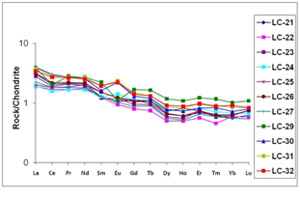Basic Science
| Title | New occurrence of a rare Troctolite intrusion from Lailunga layered Mafic-Ultramafic complex, eastern part of Central Indian Tectonic Zone, Central India |
|---|---|
| Participants | D.V.Subba Rao, Kundan Banzare+, S.L.Ramesh, M.Sathyanarayanan, A.Keshavakrishna and (+ Directorate of Geology and Mining (D G M), Bilaspur, Chhattisgarh) |
| Sponsoring Agency | CSIR-NGRI |
Work Description:
The Precambrian volcano-sedimentary supracrustal rocks of Lailunga area occurring in the eastern edge of the CITZ, central India, are intruded by multiple phases of different ultamafic-mafic and felsic rocks. The Lailunga layered complex is represented by ultramafic-mafic intrusions (Metapyroxenites/hornblendites and leuco-mafic gabbros with sulphide rich zones). The synplutonic intrusions of granodiorite and granites emplaced into the gabbros has resulted in extensive magma mixing and magma mingling zones along their contacts. In this Lailunga complex, a rare melanocratic-leucocratic troctolite intrusion is reported for the first time and is well exposed in the central part of the layered complex. The troctolite body shows N700E trend and is surrounded by leuco gabbro and mafic gabbros on either sides of the intrusion.
The troctolite is a medium grained rock and consists of mainly 30-45 modal percent cumulus olivine and 40-50 modal percent cumulus plagioclase 5-10 mm in length. The plagioclase laths are randomly oriented and are often enclosed by olivine. Oikocryst augite is common. Magnetite occurs as intercumulus mineral associated with Ilmenite. Disseminations of sulphides are conspicuous throughout the rock. Olivine crystals contain minor to significant amounts of sulphide and show no significant trends in the plot of Ni versus Fo content, (in olivines) with varying Ni and Fo Contents.
The major element compositions of intrusive rocks are controlled essentially by the proportion of cumulus plagioclase, olivine and trapped silicate liquid (Li etal. 2000). Most of the troctolite samples fall within or close to the olivine-plagioclase composition array. MgO varies from 16.69 Wt% to 23.9 Wt% and have high Cr (592 ppm) and Ni (309 ppm) contents. They show tholeiitic/iron enrichment trends in the AFM plot. In the MgO vs. Al2O3 and CaO variation plots, these rocks show decreasing Al2O3 and CaO with increasing MgO indicting olivine and pyroxene fractionation within the suite. REE patterns of troctolites show highly fractionated patterns (La/YbN = 3.1-5.5) with strong LREE enrichment (La/SmN = 1.5 to 2.4), absence of Eu anomaly, and sloping HREE or depleted HREE patterns suggesting their derivation from deeper upper mantle with minor garnet involvement in residue (Fig52.1a). In the primitive mantle normalized spidergram plots (Li etal. 2000), the troctolite samples show strong enrichment in some of the LILE (Cs, Ba, Pb and K), slight Th and U enrichment, and a slightly negative Ta+Nb anomaly. The elevated Sr and Eu concentrations reflect the modal plagioclase content., likewise Ti present in oxide minerals (Il & TiMt) and P is present in apatite (Fig.52.1b). The absolute abundances of trace elements are controlled by the amount of trapped liquid. PGE patterns of these troctolites are characterized by IPGE depletion and PPGE enrichment with a positive Rh anomaly. The PGE concentrations are distinctly low in comparison with data from many other Ni-Cu magmatic sulphide deposits of the world.

Fig.53.1a:
Chondrite normalised REE distribution patterns of the troctolites from Lailunga mafic-ultramafic complex, Chattisgarh, Central India

Fig.53.1b:
Primitive Mantle normalised spidergram plot of Lailunga troctolites.